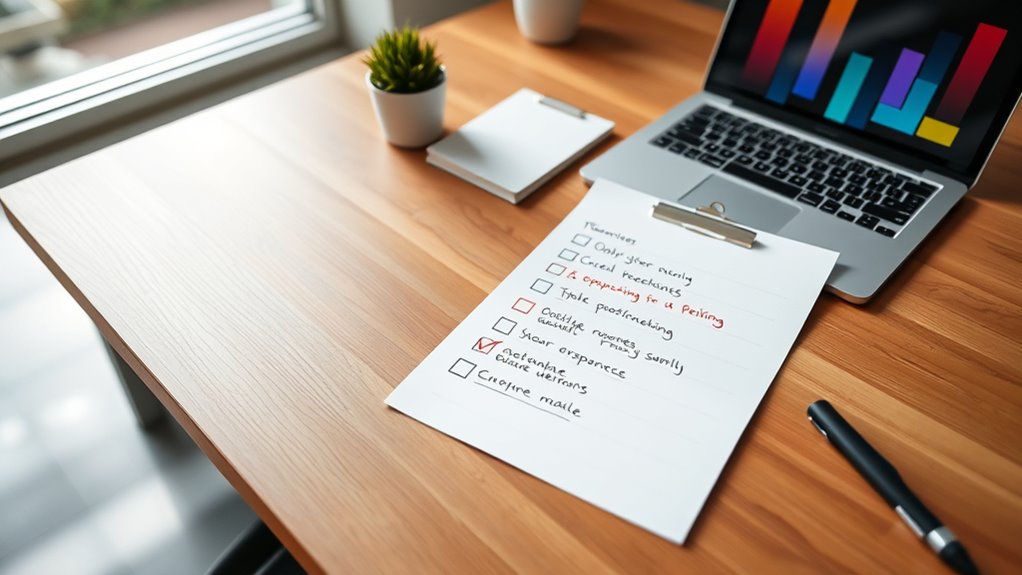To design better to-do lists, consider your working memory’s limits of managing 4 to 7 items at once. Use chunking to group related tasks and simplify complex info, making your list easier to recall. Prioritize important tasks, break bigger projects into smaller steps, and include visual cues like colors or icons. By avoiding overload and simplifying your list structure, you’ll boost focus and productivity—explore the next steps to optimize your workflow further.
Key Takeaways
- Limit to 4-7 items per list to align with working memory capacity.
- Use chunking to group related tasks and reduce cognitive load.
- Incorporate visual cues like colors and icons to enhance quick recognition.
- Prioritize high-impact tasks and review regularly to prevent overload.
- Break complex tasks into smaller, manageable steps for easier processing.
Understanding the Capacity of Working Memory

Understanding the capacity of working memory is essential because it determines how much information you can hold and manipulate at one time. Your working memory typically manages about 4 to 7 items, but this limit can be expanded through chunking techniques. Chunking involves grouping related information into meaningful units, reducing cognitive load and making complex data easier to process. For example, instead of remembering ten separate numbers, you might break them into smaller, grouped chunks. By applying chunking, you optimize your working memory, preventing overload and helping you focus on tasks more efficiently. Additionally, techniques like visualization can aid in strengthening memory retention by creating mental images of information. Recognizing these limits allows you to design better strategies, like simplifying lists or breaking tasks into smaller steps, making it easier to retain and work with information effectively. Furthermore, understanding working memory capacity can help you choose appropriate tools and methods, such as digital to-do lists or reminders, to support your cognitive load management. Being aware of memory limitations can also encourage the use of external aids like notes or apps to offload memory demands and improve productivity. Moreover, leveraging cognitive strategies can significantly enhance your ability to manage information within these constraints.
The Impact of Overloading Your To-Do List

When you overload your to-do list, you push the limits of your working memory, making it harder to focus and complete tasks effectively. Too many items create cognitive overload, overwhelming your mental capacity and reducing productivity. List clutter adds to this chaos, causing you to waste time deciding what’s urgent or important. This overload hampers your ability to prioritize and can lead to missed deadlines or forgotten tasks. To visualize this, consider the table below:
| Effect of Overloading | Consequences |
|---|---|
| Cognitive overload | Reduced focus and efficiency |
| List clutter | Increased stress and errors |
| Task confusion | Less effective task completion |
| Missed priorities | Lower overall productivity |
Reducing list clutter helps your brain process tasks better, easing cognitive overload and boosting performance. Effective list management is essential for maintaining mental clarity and productivity. Additionally, implementing prioritization strategies can help manage your workload more effectively, preventing overload in the first place. Recognizing the importance of working memory limits can guide you in designing more manageable to-do lists that support sustained focus and success.
Strategies for Simplifying and Prioritizing Tasks

To manage your working memory effectively, start by simplifying your task list and prioritizing key items. Use chunking techniques to break down complex tasks into smaller, manageable parts. For example, group related tasks like emails, calls, and errands into categories, making them easier to handle. Apply prioritization methods such as the Eisenhower Matrix or ABC prioritization to identify urgent and important tasks. Focus on high-priority items first, avoiding the temptation to multitask. Keep your list concise by removing or delaying less critical tasks. This approach reduces cognitive load, helping you stay focused and organized. Regularly review and adjust your priorities to stay aligned with your goals, ensuring your working memory isn’t overwhelmed by unnecessary details. Incorporating music therapy techniques such as calming sounds can also improve concentration and mental clarity during task management.
Designing Visual and Structured Lists for Better Recall

Creating visual and structured lists can considerably boost your recall by organizing information in a clear, easily digestible format. Use chunking techniques to group related tasks or details, making them easier to remember. For example, bundle similar items or steps into single categories rather than listing each one separately. Incorporate visual cues like icons, colors, or bullet points to highlight priorities and differentiate tasks. These cues help your brain quickly identify important information and reduce cognitive load. A well-structured list with clear sections and visual markers makes it easier to scan and recall what’s next. Additionally, auditory cues can reinforce memory retention, especially when combined with visual strategies. Leveraging cybersecurity threats awareness in your lists can help you stay prepared against evolving risks. Incorporating principles from textile art such as symmetry and texture in your list design can also make the information more engaging and memorable. Employing visual organization techniques further enhances your ability to quickly access and remember information. For example, incorporating meditation practices can improve focus and mental clarity, making list management more effective. By designing lists that leverage chunking techniques and visual cues, you optimize your working memory and make task management more efficient.
Practical Tips for Maintaining a Manageable Workflow

Maintaining a manageable workflow requires intentional strategies to prevent overload and boost productivity. One effective approach is using chunking techniques—breaking complex tasks into smaller, manageable parts. This reduces your mental load, making tasks feel less overwhelming and easier to complete. Prioritize your to-do list by focusing on high-impact items first, and set realistic limits on daily goals to avoid taking on too much. Regularly review and adjust your workload to stay aligned with your capacity. Minimize distractions and create focused work sessions to improve efficiency. Incorporating reviews and comparisons of your progress can also help identify areas for improvement, ensuring you stay on track. Additionally, being aware of working memory limits can help you design better to-do lists that suit your cognitive capacity. Recognizing the importance of community resilience in emergency preparedness can also enhance your planning and resourcefulness. Understanding how narcissistic behaviors impact team dynamics and communication can help you develop strategies to maintain a healthy work environment. By intentionally managing how you break down tasks and limiting your mental load, you can stay organized, reduce stress, and maintain a steady, productive workflow.
Frequently Asked Questions
How Does Stress Affect Working Memory Capacity During Task Management?
Stress overload can considerably reduce your working memory capacity during task management. When you’re stressed, your mind experiences memory fatigue, making it harder to hold and manipulate information. This impairs your ability to prioritize, plan, and complete tasks efficiently. As a result, you might forget important steps or become overwhelmed easily. Managing stress through breaks or relaxation techniques helps preserve your working memory, enabling better focus and task execution.
Can Physical Environment Changes Improve Working Memory for To-Do Lists?
Changing your physical environment can boost your working memory for to-do lists. Environmental cues like clear signage or organized spaces help you focus and recall tasks more easily. Reducing physical clutter minimizes distractions, making it easier to concentrate on your list. By creating an environment with intentional cues and tidiness, you support your memory, allowing you to manage tasks more effectively and stay on top of what needs to be done.
What Role Does Digital Versus Paper Lists Play in Memory Retention?
You might think digital lists are better, but studies show handwriting habits enhance memory retention more effectively. Digital clutter can overwhelm your working memory, making it harder to focus on tasks. Writing by hand engages your brain differently, helping you remember better. So, if you want to boost your memory, opt for paper lists or minimize digital distractions, rather than relying solely on digital lists with their potential for clutter.
How Do Individual Differences Influence Working Memory Limits?
You should consider that individual differences in cognitive variability and memory capacity substantially influence how well you manage information. Your working memory limits vary based on factors like age, stress, or practice, affecting how much you can hold and process at once. Recognizing these differences helps you tailor your to-do lists, making them more effective by accommodating your unique cognitive profile and reducing overload.
Are There Specific Exercises to Enhance Working Memory for Task Planning?
Think of your brain as a muscle that needs lifting. You can boost your working memory by practicing mnemonic strategies, which act like mental tools, or engaging in cognitive training exercises. These workouts strengthen your memory’s flexibility, making task planning smoother. Regularly challenging yourself with brain games or memory drills helps expand your mental capacity, turning you into a more efficient planner with each session.
Conclusion
To truly tame your to-do list, focus on filtering, formatting, and focusing. Keep tasks clear, concise, and categorized to combat cognitive clutter. Simplify your schedule, prioritize your priorities, and prevent overwhelm. When you design with your working memory in mind, you’ll find more focus, fewer frustrations, and a more fulfilling flow. Remember, a well-woven, well-organized list isn’t just easier to manage — it makes your mind more mindful and motivated.









